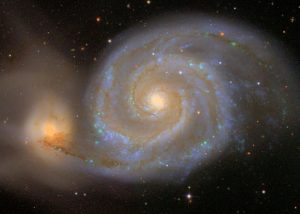
MINNEAPOLIS/ST. PAUL, Minn. — More than 83,000 volunteer citizen scientists partnered with professional astronomers to examine more than 300,000 galaxies in an online project that would have taken approximately 30 years of full-time work by one researcher to complete, according to a paper co-authored by a University of Alabama researcher.
The project, named Galaxy Zoo 2, is the second phase of a crowdsourcing effort to categorize galaxies in the universe.
“Once again, I am stunned at not only the breadth but the depth of public interest in the Galaxy Zoo project,” said Dr. William Keel, University of Alabama professor of astronomy who co-authored a paper detailing the project that published Sept. 23 in the Monthly Notices of the Royal Astronomical Society.
“In this round, participants have gone through much more extensive examination of 300,000 galaxy images, delivering results that are already enabling a much richer set of astronomical studies than the original Galaxy Zoo.”
Within weeks of the original Galaxy Zoo’s July 2007 inception, Keel became one of several professional astronomers intricately involved in the project.
Researchers said computers are good at automatically measuring properties such as size and color of galaxies, but more challenging characteristics, such as shape and structure, can only be determined by the human eye.
An international group of researchers, led by the University of Minnesota, has just produced a catalog of this new galaxy data. This catalog is 10 times larger than any previous catalog of its kind. It is available online at data.galaxyzoo.org.
View examples of images categorized by citizen scientists at http://z.umn.edu/galaxyimages.
“This catalog is the first time we’ve been able to gather this much information about a population of galaxies,” said Kyle Willett, a physics and astronomy postdoctoral researcher in the University of Minnesota’s College of Science and Engineering and the paper’s lead author. “People all over the world are beginning to examine the data to gain a more detailed understanding of galaxy types.”
Between Feb. 2009 and April 2010, more than 83,000 Galaxy Zoo 2 volunteers from around the world looked at images online gathered from the Sloan Digital Sky Survey. They answered questions about the galaxy, including whether it had spirals, the number of spiral arms present, or if it had galactic bars, which are long extended features that represent a concentration of stars. Each image was classified an average of 40-45 times to ensure accuracy. More than 16 million classifications of more than 300,000 galaxies were gathered representing about 57 million computer clicks.
When volunteers were asked why they got involved in the project, the most common answer was because they enjoyed contributing to science. Researchers estimate that the effort of the volunteers on this project represents about 30 years of full-time work by one researcher.
“Widespread Internet access has brought out a new level of partnership between professional astronomers and citizen scientists,” said UA’s Keel, “and we can only look forward to further projects in this direction (such as the Hubble Zoo projects already in motion).”
To help create the next catalog, volunteer citizen scientists continue to be needed for the project. To participate, visit www.galaxyzoo.org. No special skills are needed, and volunteers can start classifying galaxies and helping the scientists within minutes of going to the website.
In addition to Willett and Keel, other authors of the research paper include Chris Lintott, Oxford Astrophysics and Adler Planetarium; Lucy Fortson, University of Minnesota; Steven Bamford, University of Nottingham; Karen Masters, Robert Nichol and Daniel Thomas, University of Portsmouth and South East Physics Network; Brooke Simmons and Robert Simpson, Oxford Astrophysics; Kevin Casteels, University of Barcelona; Edward Edmondson and Thomas Melvin, University of Portsmouth; Sugata Kaviraj, Oxford Astrophysics and University of Hertfordshire; M. Jordan Raddick, Johns Hopkins University; Kevin Schawinski, ETH Zurich; Ramin Skibba, University of California, San Diego; and Arfon Smith, Adler Planetarium.
The research was funded primarily by the National Science Foundation and the Leverhulme Trust. Galaxy Zoo is one of the many online citizen science projects made available by the Zooniverse.org team.
To read the full research paper entitled “Galaxy Zoo 2: detailed morphological classifications for 304,122 galaxies from the Sloan Digital Sky Survey,” visit the Monthly Notices of the Royal Astronomical Society website.
UA’s department of physics and astronomy is part of the College of Arts and Sciences, the University’s largest division and the largest liberal arts college in the state. Students from the College have won numerous national awards including Rhodes Scholarships, Goldwater Scholarships and memberships on the USA Today Academic All American Team.
Contact
Chris Bryant, UA media relations, 205/348-8323, cbryant@ur.ua.edu
Source
Dr. William Keel, wkeel@as.ua.edu (accessible only via e-mail prior to Sept. 30)